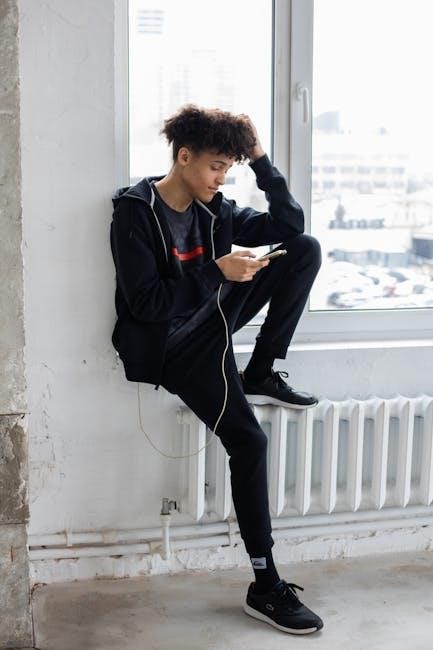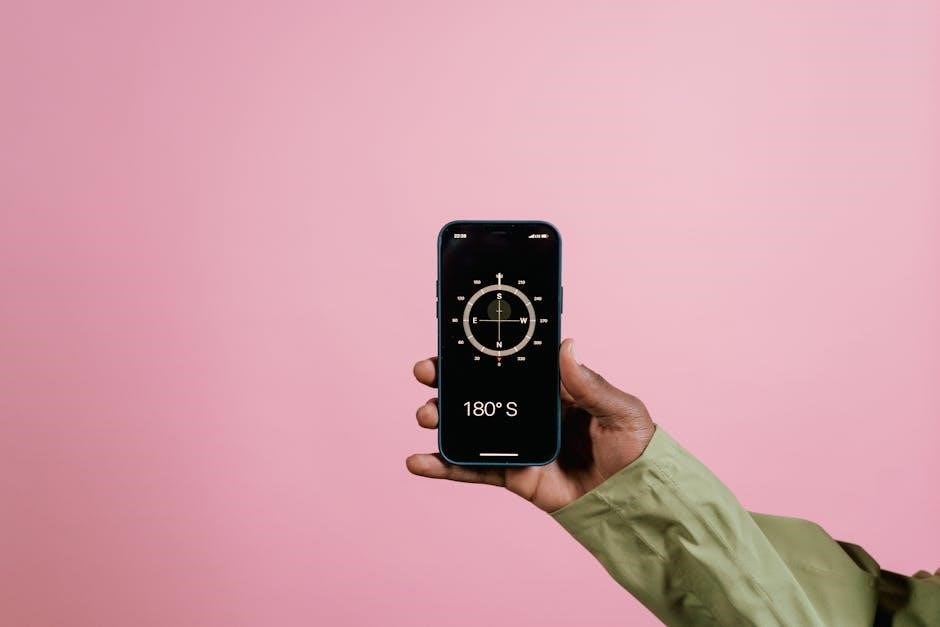
Chemistry is the study of matter and energy‚ exploring their properties‚ interactions‚ and transformations. It involves understanding chemical structures‚ reactions‚ and the scientific method to analyze data and draw conclusions.
1.1 What is Chemistry?
Chemistry is the scientific study of matter and energy‚ focusing on the composition‚ properties‚ and reactions of substances. It explores how atoms and molecules interact to form new materials and undergo transformations. Chemistry is a central science‚ connecting physics‚ biology‚ and geology. It involves understanding chemical structures‚ bonding‚ and energy changes. Key concepts include the periodic table‚ chemical equations‚ and the scientific method. Chemistry is essential for understanding the natural world and developing new technologies‚ medicines‚ and materials. Studying chemistry requires a strong foundation in concepts like elements‚ compounds‚ and chemical reactions‚ which are fundamental to solving problems in this field.
1.2 Branches of Chemistry
Chemistry is divided into several branches‚ each focusing on specific aspects of chemical study. Organic Chemistry explores carbon-based compounds and their reactions. Inorganic Chemistry deals with non-carbon compounds‚ such as minerals and metals. Physical Chemistry examines the physical properties and processes of molecules‚ including thermodynamics and kinetics. Analytical Chemistry involves the analysis and identification of substances. Biochemistry studies chemical processes in living organisms. Other branches include Environmental Chemistry‚ Nuclear Chemistry‚ and Materials Chemistry. Understanding these branches provides a comprehensive foundation for tackling various topics in chemistry.
1.3 Scientific Method
The scientific method is a systematic process used to develop and test scientific knowledge. It begins with observations and questions‚ followed by research and hypothesis formation. Experiments are designed to test the hypothesis‚ and data is collected and analyzed. Based on the results‚ conclusions are drawn‚ and the hypothesis is either accepted or rejected. This method emphasizes objectivity‚ reproducibility‚ and critical thinking. Understanding the scientific method is crucial for conducting experiments and analyzing data in chemistry. It provides a structured approach to problem-solving and ensures the validity of scientific findings.

Atomic Structure
Atomic structure explores the composition of atoms‚ including protons‚ neutrons‚ and electrons. It delves into the periodic table’s organization and electron configuration‚ explaining chemical properties and behavior.
2.1 Structure of the Atom
The atom consists of a nucleus containing protons and neutrons‚ surrounded by electrons in orbitals. Protons determine the element‚ while electron configuration influences chemical properties. The nucleus holds most of the atom’s mass‚ and electrons occupy specific energy levels or shells. Understanding atomic structure is crucial for predicting behavior in chemical reactions and interactions. Key concepts include quantum numbers‚ electron spin‚ and the periodic table’s arrangement‚ which reflects increasing atomic number and recurring chemical properties.
2.2 Periodic Table
The periodic table organizes elements by atomic number‚ showcasing recurring chemical properties. Elements are arranged in rows (periods) and columns (groups)‚ reflecting periodic trends. Metals‚ nonmetals‚ and metalloids are grouped‚ with hydrogen often placed separately; The table predicts behavior based on electron configuration and periodicity. Mendeleev’s development highlighted patterns‚ enabling predictions of undiscovered elements. Key trends include atomic radius‚ electronegativity‚ and ionization energy‚ which increase across periods and decrease down groups. Mastery of the periodic table is essential for analyzing chemical behavior and solving problems in stoichiometry and bonding.
2.3 Electron Configuration
Electron configuration describes the distribution of electrons in an atom’s orbitals. It follows the Aufbau principle‚ Pauli Exclusion Principle‚ and Hund’s Rule. Electrons fill lower energy levels first‚ with a maximum of two electrons per orbital. Subshells (s‚ p‚ d‚ f) hold specific numbers of electrons. The ground state configuration minimizes energy‚ while excited states involve electrons moving to higher orbitals. Exceptions occur for elements like chromium and copper‚ where stability is prioritized. Understanding electron configuration is key for predicting chemical properties‚ ion formation‚ and bonding patterns.

Chemical Bonding
Chemical bonding involves the attraction between atoms to form stable molecules. It includes ionic‚ covalent‚ and metallic bonds‚ shaping molecular structures and determining chemical properties and reactivity.
3.1 Types of Bonds
In chemistry‚ bonds are forces that hold atoms together in molecules. The primary types include ionic bonds‚ formed through electron transfer between metals and non-metals‚ and covalent bonds‚ involving electron sharing‚ commonly between non-metals. Ionic bonds result in the formation of ions held together by electrostatic attraction‚ while covalent bonds create stable molecules like H₂ or O₂. Additionally‚ metallic bonds occur in metals‚ where electrons move freely among atoms. Understanding bond types is crucial for predicting chemical behavior‚ solubility‚ and conductivity.
3.2 Lewis Structures
Lewis structures are visual representations of molecules showing valence electrons and bonding. To draw them‚ determine the total valence electrons‚ place the central atom‚ and arrange surrounding atoms. Bonds are formed by sharing electrons‚ with lone pairs filled around each atom. Follow octet rules‚ exceptions for molecules like BF₃ or CO₂. Lewis structures help predict molecular geometry‚ polarity‚ and reactivity. They are essential for understanding concepts like resonance and formal charges‚ which are critical for analyzing chemical behavior and reaction mechanisms. Practicing Lewis structures improves your ability to visualize molecular interactions and solve problems in organic and inorganic chemistry effectively.
3.3 Molecular Geometry
Molecular geometry refers to the three-dimensional arrangement of atoms in a molecule‚ determined by the repulsion between electron pairs. Using VSEPR theory‚ predict shapes like linear‚ trigonal planar‚ tetrahedral‚ trigonal bipyramidal‚ and octahedral. Lone pairs influence geometry‚ as seen in bent or seesaw shapes. Understanding molecular geometry helps explain physical properties‚ such as polarity and solubility. For exam success‚ practice drawing structures and identifying geometries. Flashcards and online tools can aid memorization. Mastering this concept is crucial for analyzing chemical behavior and solving problems in advanced topics like orbital hybridization and molecular polarity.
Chemical Reactions
Chemical reactions involve the transformation of substances into new products. Mastering reaction types‚ balanced equations‚ and stoichiometry is essential. Catalysts and reaction conditions also play a critical role.
4.1 Types of Reactions
Chemical reactions are classified into several types‚ including synthesis‚ decomposition‚ single replacement‚ double replacement‚ combustion‚ and acid-base reactions. Each type follows specific patterns. For example‚ synthesis reactions combine two substances to form a compound‚ while decomposition breaks one substance into simpler products. Single replacement involves one element displacing another‚ and double replacement swaps ions between compounds. Combustion typically involves a substance reacting with oxygen to produce heat and light. Acid-base reactions create salts and water. Understanding these types and their examples is crucial for identifying and predicting reaction outcomes‚ aiding in problem-solving during exams.
4.2 Stoichiometry
Stoichiometry is the calculation of the quantitative relationships between reactants and products in chemical reactions. It involves balancing chemical equations and using mole ratios to determine the amounts of substances involved. Key concepts include limiting reagents‚ percent yield‚ and molar masses. Mastery of stoichiometry is essential for solving problems in chemistry‚ as it applies to reactions in various fields. Practice with different types of problems‚ such as synthesis and decomposition reactions‚ helps build proficiency. Understanding stoichiometric calculations is critical for accurately predicting reaction outcomes and optimizing chemical processes.
4.3 Balancing Equations
Balancing chemical equations is a fundamental skill in chemistry‚ ensuring the law of conservation of mass is upheld. Start by counting atoms of each element on both sides. Assign variables to unknowns and adjust coefficients systematically. Polyatomic ions and diatomic molecules often require special attention. Practice with simple synthesis and decomposition reactions before tackling more complex scenarios. Reviewing common reaction types‚ such as combustion and acid-base reactions‚ can improve proficiency. Using flashcards to memorize common formulas and states of matter can also aid in balancing equations efficiently. Regular practice is key to mastering this essential chemistry skill.

Thermodynamics
- Laws of thermodynamics govern energy transformations and its distribution.
- Enthalpy (ΔH) and entropy (ΔS) measure system changes.
- Gibbs free energy (ΔG) predicts reaction spontaneity.
5.1 Laws of Thermodynamics
The laws of thermodynamics are fundamental principles governing energy and its interactions. The first law states that energy cannot be created or destroyed‚ only transformed. The second law introduces entropy‚ a measure of disorder‚ which always increases in an isolated system. The third law relates to absolute zero‚ where entropy reaches its minimum value. These laws are crucial for understanding energy conservation‚ direction of natural processes‚ and the feasibility of chemical reactions. Mastering these concepts is essential for analyzing thermodynamic systems and predicting reaction outcomes in chemistry.
5.2 Enthalpy and Entropy
Enthalpy (H) measures the total energy of a system‚ including internal energy and the energy associated with pressure and volume. Entropy (S) quantifies disorder or randomness in a system. The second law of thermodynamics states that entropy tends to increase over time in an isolated system. Changes in enthalpy and entropy determine the spontaneity of a reaction. A negative change in enthalpy (ΔH) indicates an exothermic process‚ while a positive ΔH indicates endothermic. Similarly‚ an increase in entropy (ΔS) favors spontaneity. Understanding these concepts is vital for analyzing thermodynamic processes and predicting reaction outcomes.
5.3 Gibbs Free Energy
Gibbs Free Energy (ΔG) measures the energy available to do work in a system at constant temperature and pressure. It combines enthalpy (ΔH) and entropy (ΔS) changes‚ calculated as ΔG = ΔH ⎼ TΔS. A negative ΔG indicates a spontaneous process‚ while a positive ΔG suggests non-spontaneity. At equilibrium‚ ΔG is zero. The standard Gibbs free energy change (ΔG°) relates to the equilibrium constant (K) via ΔG° = -RT ln K. Understanding Gibbs Free Energy is crucial for predicting reaction spontaneity and equilibrium behavior‚ making it a cornerstone of thermodynamic analysis in chemistry.

Kinetics
Kinetics studies the rates of chemical reactions and factors influencing them. It involves the rate law‚ activation energy‚ and how concentrations‚ temperature‚ and catalysts affect reaction speeds.
6.1 Rate of Reactions
The rate of a reaction measures how quickly reactants are converted into products. It is influenced by concentration‚ temperature‚ surface area‚ and catalysts. Higher concentration or temperature increases the rate‚ while catalysts lower activation energy. Inhibitors can slow reactions. Rates are determined experimentally using timers‚ spectrophotometers‚ or titrations. Graphing concentration vs. time helps calculate rate constants. Understanding mechanisms and rate-determining steps is crucial for predicting outcomes. Factors affecting rates are key to controlling reaction efficiency in industrial and biological processes.
6.2 Factors Affecting Rate
Several factors influence reaction rates‚ including concentration‚ temperature‚ surface area‚ and catalysts. Increasing concentration or temperature accelerates reactions by enhancing molecular collisions. Larger surface areas‚ such as finely divided reactants‚ also increase reaction rates. Catalysts lower activation energy‚ speeding up reactions without being consumed. Inhibitors‚ conversely‚ slow reactions by increasing activation energy. Understanding these factors is crucial for controlling reaction efficiency in laboratory and industrial settings. Students should practice analyzing how these factors interact and predict their effects on reaction rates for exam questions.
6.3 Catalysts
Catalysts are substances that accelerate chemical reactions without being consumed in the process. They function by lowering the activation energy required for a reaction to occur‚ enabling it to proceed faster. Catalysts play a crucial role in both natural processes and industrial applications. For example‚ enzymes act as biological catalysts‚ while metals like platinum are used in catalytic converters to reduce emissions. Understanding catalysts is essential for controlling reaction rates and optimizing processes. Students should review examples of catalysts‚ their mechanisms‚ and their significance in chemistry for exam questions on reaction kinetics.

Equilibrium
Chemical equilibrium occurs when reversible reactions reach a balance‚ with forward and reverse rates equal; Le Chatelier’s Principle explains shifts in equilibrium due to changes in conditions.
7.1 Le Chatelier’s Principle
Le Chatelier’s Principle states that when a system at equilibrium is disturbed‚ it adjusts to minimize the effect of the change. This principle applies to changes in concentration‚ pressure‚ or temperature. For example‚ increasing the concentration of a reactant shifts the equilibrium toward products‚ while decreasing it shifts toward reactants. Changes in pressure affect gaseous reactions‚ favoring the side with fewer moles of gas. Temperature changes impact reactions by favoring the endothermic or exothermic direction. Understanding this principle is crucial for predicting equilibrium shifts and solving related problems in chemistry exams.
7.2 Kp and Kc
Kp and Kc are equilibrium constants used to describe the extent to which a chemical reaction proceeds. Kc (equilibrium constant in terms of concentration) is calculated using the concentrations of reactants and products‚ while Kp (equilibrium constant in terms of pressure) uses partial pressures‚ primarily for gaseous reactions. Both constants help predict the position of equilibrium and are temperature-dependent. Understanding the relationship between Kp and Kc‚ as well as how to calculate them‚ is essential for solving equilibrium problems. They are widely used in chemistry to analyze reaction spontaneity and equilibrium behavior.
7.3 ICE Tables
ICE Tables are a useful tool in chemistry for analyzing chemical equilibria. ICE stands for Initial‚ Change‚ and Equilibrium concentrations. To set up an ICE Table‚ start by writing the balanced chemical equation and identifying all reactants and products. Under the Initial column‚ list the starting concentrations of each substance. In the Change column‚ express how each concentration changes as the reaction proceeds‚ using variables like “x” or “s” based on stoichiometric coefficients. Finally‚ the Equilibrium column is the sum of Initial and Change concentrations. ICE Tables help in setting up equilibrium expressions (Kc or Kp) and solving for unknown concentrations or equilibrium constants. Regular practice with different reaction types enhances proficiency in using ICE Tables effectively for exams.

Acids and Bases
Acids and bases are fundamental in chemistry‚ defined by their ability to donate or accept protons. Understanding their theories‚ pH‚ pOH‚ and electrolyte behavior is crucial for exams.
8.1 Theories of Acids and Bases
Theories of acids and bases explain their chemical behavior. The Arrhenius theory defines acids as H⁺ donors and bases as OH⁻ producers in water. The Bronsted-Lowry theory expands this‚ describing acids as proton donors and bases as proton acceptors. The Lewis theory broadens the concept further‚ characterizing acids as electron pair acceptors and bases as electron pair donors. Understanding these theories is essential for analyzing acid-base reactions‚ strengths‚ and applications in chemistry. They provide frameworks for predicting behavior in various solutions and reactions‚ making them foundational for exam preparation.
8.2 pH and pOH
pH and pOH are measures of the acidity and basicity of a solution. pH is calculated as the negative logarithm of hydrogen ion concentration (-log[H⁺])‚ while pOH is the negative logarithm of hydroxide ion concentration (-log[OH⁻]). In aqueous solutions at 25°C‚ pH + pOH = 14. A pH of 7 is neutral‚ below 7 is acidic‚ and above 7 is basic. Understanding pH and pOH is crucial for analyzing chemical reactions‚ buffer solutions‚ and acid-base equilibria. These concepts are fundamental for solving problems involving solution chemistry and preparing for exams.
8.3 Strong and Weak Electrolytes
Strong electrolytes completely dissociate in water‚ producing a high concentration of ions‚ while weak electrolytes partially dissociate. Examples of strong electrolytes include NaCl‚ HCl‚ and KOH‚ which fully break into ions. Weak electrolytes‚ such as acetic acid (CH₃COOH) or ammonia (NH₄OH)‚ only partially ionize. Understanding the difference is crucial for calculating solution conductivity‚ solubility‚ and reaction rates. In exam problems‚ identifying electrolyte strength helps determine the correct approach for pH calculations and equilibrium reactions. Recognizing strong and weak electrolytes is essential for solving chemistry problems and understanding ionic behavior in aqueous solutions.

Electrochemistry
Electrochemistry studies the relationship between electrical energy and chemical reactions‚ focusing on processes like oxidation‚ reduction‚ and electron transfer. It includes topics such as electrochemical cells‚ batteries‚ and electrolysis.
9.1 Electrochemical Cells
Electrochemical cells are devices that convert chemical energy into electrical energy or vice versa. They consist of two electrodes and an electrolyte‚ enabling electron transfer. Galvanic cells produce electricity through spontaneous redox reactions‚ while electrolytic cells require an external voltage to drive non-spontaneous reactions. Key concepts include anodes (oxidation site)‚ cathodes (reduction site)‚ and the flow of electrons. Understanding cell notation‚ standard electrode potentials‚ and cell reactions is crucial. These cells are fundamental in applications like batteries‚ electrolysis‚ and corrosion prevention‚ making them vital for chemistry exams.
9.2 Batteries and Corrosion
Batteries are electrochemical cells that store energy‚ converting chemical energy into electrical energy. Primary batteries‚ like alkaline‚ are non-rechargeable‚ while secondary batteries‚ such as lead-acid‚ are rechargeable. Corrosion is an electrochemical process causing material degradation‚ often due to environmental factors. Rusting of iron is a common example. Understanding battery types‚ electrode materials‚ and reaction mechanisms is key for exams. Corrosion prevention methods‚ such as coatings or cathodic protection‚ are also important topics. These concepts are essential for energy storage and material preservation‚ making them critical for chemistry final exams.
9.3 Electrolysis
Electrolysis involves using electrical energy to drive non-spontaneous chemical reactions. It occurs in electrolytic cells‚ where electrodes are submerged in an electrolyte solution. The anode undergoes oxidation‚ while the cathode experiences reduction. Key applications include metal extraction‚ such as aluminum production‚ and water decomposition into hydrogen and oxygen. Understanding electrode reactions‚ current flow‚ and electrolyte concentration is crucial. Electrolysis is vital in industrial processes and laboratory demonstrations‚ showcasing the practical use of electrochemistry. Students should focus on reaction mechanisms and efficiency factors for exam success‚ as these concepts are fundamental to electrochemical principles and applications.

Study Strategies
Effective study strategies for chemistry involve active learning and time management. Review notes‚ practice problems‚ and use flashcards to reinforce concepts. Join study groups and seek clarification on challenging topics to ensure comprehensive understanding and exam readiness.
10.1 Review Notes and Textbook
Thoroughly reviewing your class notes and textbook is essential for exam success. Organize your notes by topic‚ summarizing key concepts and reactions. Compare your notes with classmates to fill gaps. Pay attention to highlighted or underlined sections‚ as they often indicate important ideas. Use flashcards to memorize definitions and formulas. Skim through textbook chapters‚ focusing on headings‚ subheadings‚ and practice problems. Create concept maps or outlines to visualize relationships between topics. Ensure you understand all derivations and mechanisms. Regular review helps retain information and identifies areas needing more focus. Consistency is key to mastering chemistry concepts.
10.2 Practice Past Papers
Practicing past papers is a proven strategy to excel in your chemistry final exam. By solving previous years’ questions‚ you familiarize yourself with exam patterns‚ question types‚ and time management. Start with untimed practice to focus on understanding concepts‚ then transition to timed sessions to simulate exam conditions. Review your answers‚ focusing on weak areas that need improvement. Use official solutions to verify your work and learn from mistakes. Regular practice builds confidence and problem-solving skills‚ ensuring you’re well-prepared for the actual exam. This method helps identify gaps in knowledge and improves retention of key concepts effectively.
10.4 Use Flashcards
Flashcards are a powerful tool for memorizing key terms and concepts in chemistry. By creating cards with terms on one side and definitions or explanations on the other‚ you can quickly review and retain information. Focus on high-yield topics like formulas‚ reactions‚ and important definitions. Use apps like Quizlet or Anki for digital flashcards‚ which offer spaced repetition and tracking features. Regular review sessions help reinforce memory and ensure long-term retention. Flashcards are particularly useful for visual learners and can be a convenient study aid for on-the-go preparation‚ making them an essential part of your study routine.
10.5 Join Study Groups
Joining study groups is an effective way to collaborate with peers‚ discuss challenging topics‚ and gain different perspectives on chemistry concepts. Active participation in group discussions enhances understanding and retention of material. Study groups allow you to teach others‚ reinforcing your own knowledge‚ and provide a platform to ask questions and clarify doubts. Group members can share resources‚ such as notes and practice problems‚ and work together on past papers. Explaining concepts aloud helps solidify your understanding‚ while hearing others explain can illuminate areas you found difficult. Regular group sessions create accountability and motivation‚ ensuring consistent preparation for the exam.

Final Exam Practice Questions
Practice questions are essential for exam preparation. They cover multiple-choice‚ short-answer‚ and essay formats‚ helping you assess knowledge‚ identify weak areas‚ and improve time management skills.
11.1 Multiple Choice Questions
Multiple-choice questions (MCQs) are a key component of the final exam‚ testing your ability to recall and apply chemical concepts quickly and accurately. To excel‚ focus on understanding core principles rather than memorizing facts. Practice identifying distractors and eliminating incorrect options to improve your guessing strategy. Reviewing past papers will help you familiarize yourself with common question formats and high-yield topics. Time management is crucial; allocate a set time per question to avoid spending too long on challenging ones. After practice‚ analyze your mistakes to reinforce weak areas and build confidence for the actual exam.
11.2 Short Answer Questions
Short answer questions assess your ability to clearly and concisely communicate chemical concepts. To succeed‚ focus on understanding key principles and practicing concise explanations. Review past papers to identify common question types and develop structured responses. Use bullet points or diagrams if allowed to organize your thoughts. Time management is critical; allocate a set timeframe per question to ensure completion. Practice writing under timed conditions to refine your ability to articulate answers effectively. Regular review of mistakes will help improve accuracy and clarify your writing style for better grades.
11.3 Essay Questions
Esey questions require in-depth analysis and detailed explanations of chemical concepts. To excel‚ thoroughly understand key topics and practice articulating complex ideas logically. Review past exams to identify recurring themes and structure your responses with clear introductions‚ body paragraphs‚ and conclusions. Use examples and diagrams to support your arguments. Time management is crucial; outline your essay before writing to ensure coherence. Regularly review and refine your writing style to enhance clarity and depth. Understanding the marking scheme will help you address all parts of the question‚ maximizing your score.









